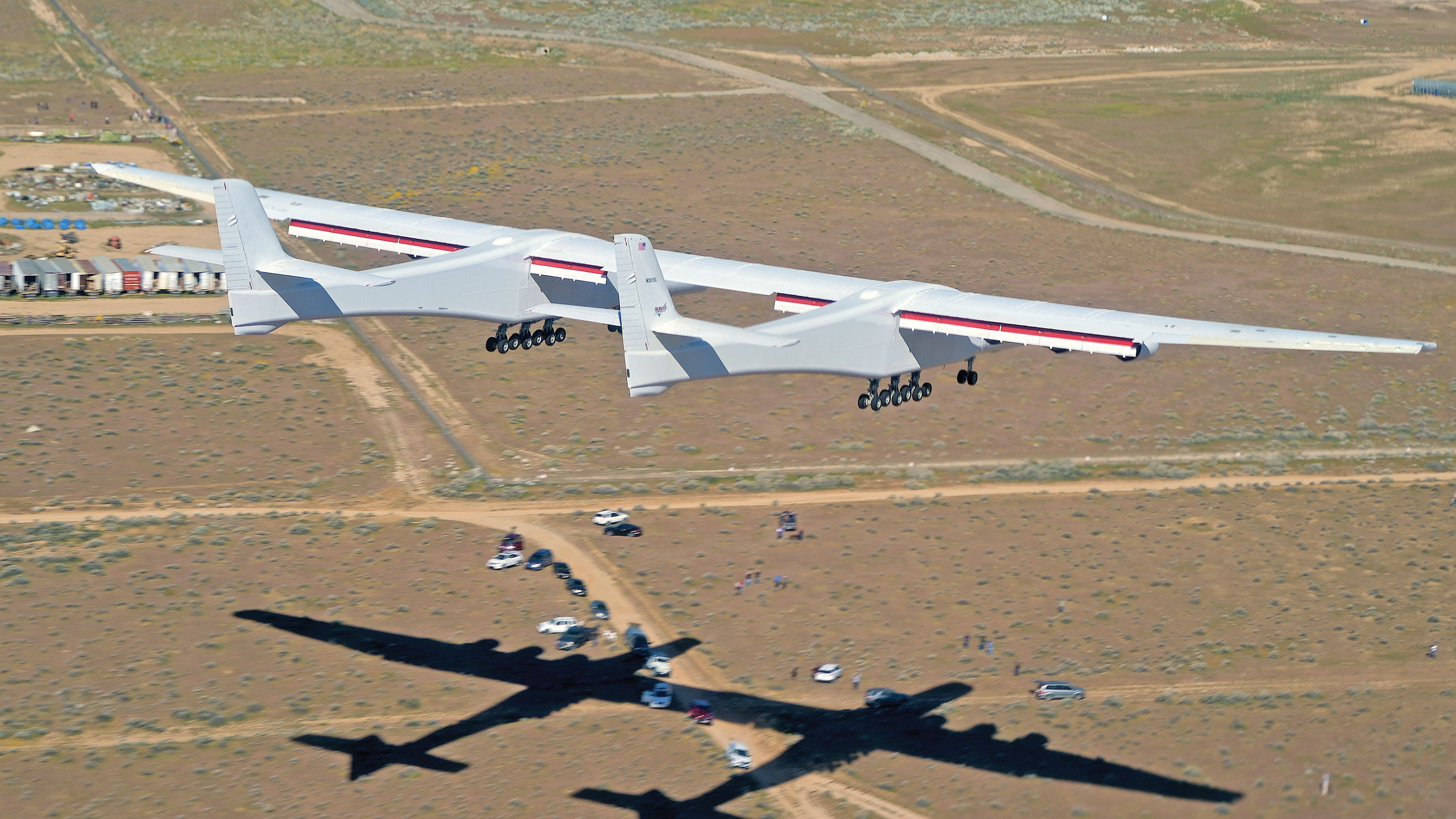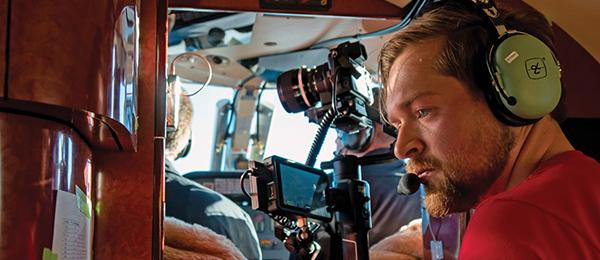
Written by Lucas Weakley New Technology As seen in the Winter 2020 issue of Park Pilot
>> Nearly two years ago, I moved from Florida to California to start a career at Scaled Composites (scaled.com) using my aeronautical engineering degree. For those who aren’t familiar, Scaled Composites is an aircraft prototyping company that was founded by visionary airplane designer Burt Rutan. The company specializes in the holistic approach of taking an aerospace idea through the design phase, rapidly building the entire vehicle (manufacturing most of the components in-house), and then flying the aircraft to execute its mission with the company’s on-staff test pilots.

Notice the scale of the shadow that is cast on spectators’ cars as the Stratolaunch approaches for landing.
Scaled’s portfolio includes the Beechcraft Starship, SpaceShipOne (the first commercial spacecraft), Proteus (an altitude world-record-holding research platform), the recent Stratolaunch aircraft, and many more. As stated on the company’s website, “We are driven by being challenged, pursuing breakthroughs, and pushing limits.”
To meet these accomplishments, Scaled Composites often tasks small teams of multifaceted engineers to follow projects through all parts of their development. Many of these interest-varied aircraft engineers are also modelers.
In this column, I’ll discuss how the knowledge I gained as an RC modeler allows me to do my job at Scaled Composites. In the process, I hope to also share a tiny glimpse into our aircraft prototyping day job.
My job title at Scaled Composites is design engineer, along with all of the other engineers who aren’t managing programs. At Scaled, we aren’t labeled with a specialized engineering discipline (unless we want to be); instead, we are led to fill any need that our current program demands.
When I was interviewing for the job, one of my interviewers told me that he had designed landing gear, the structure of a wing, laid out an instrument panel, drawn the aircraft’s systems schematics, and spent time in the control room during flight testing—all within the same year. While the comparison might sound silly to some, this way of completing projects mirrors building an RC airplane.
As modelers, we have to complete all parts of an airplane: design, assembly, routing wires, connecting servos, testing the systems, installing the powerplant, balancing the aircraft, and being our own test pilot. Even when we are building a kit, many of these skills are still needed. Although the risks are small and most models can be finished in a weekend, the process remains the same for full-scale airplanes.

Lucas checks the next flight test point shortly after climbout during the Stratolaunch’s first flight. Photo by Sean Willis.
Approximately five months after I started working at Scaled, I was tasked with designing and manufacturing a pod for Proteus. It would be roughly 8 feet long, interfacing an existing component to the vehicle and attaching it in a way never done before. It also had to fly in less than four weeks.
In those few weeks, I lofted the pod in CAD, designed its substructure, did calculations to make sure it wouldn’t break, reviewed the design with senior engineers, published instructions to our CNC and fabrication shops, ordered hardware, managed the fabricators’ progress and schedule, helped lay up the carbon-fiber parts when the engineering was done, fit-checked the pod, organized a structural test two days before the first flight, and sat in the right seat in the chase airplane to visually inspect the pod during flight. I can easily say that this was the hardest I had worked the entire year—but also the most fun work I had done!
During that project, I carried the roles of several positions. This is how all projects are run at Scaled Composites. Engineers take on a lot of responsibility and manage their own work with light management, allowing Scaled to meet such seemingly impossible deadlines by simplifying the engineering process. The task-focused mindset that lets me do this work is something that I gained, in large part, from managing my own RC airplane projects.
Another crucial facet of being an engineer at Scaled is knowing how to build your own designs. If you’ve ever heard the frustration-fueled discussions between mechanics and engineers, then you might understand why this is important. It’s so easy to get carried away in the computer, making pretty fittings and complex surfaces, while losing track of how the parts will be assembled or whether the access door is even big enough to fit standard tools.
These parts can still be made by our machinists and fabricators, but by tweaking the design slightly, they’re produced in a fraction of the time, while being easier to assemble and maintain.
Working with my hands as a modeler and designing components that I have to build helps bring a manufacturability and usability mindset to my work.
Although we are usually engineering during working hours, our programs sometimes demand our other skillsets, which we’re encouraged to utilize. Several engineers are extremely talented RC pilots and fill the role as UAS (unmanned aircraft system) test pilots when the aircraft they’ve been designing is ready to fly.
We also have a presence as modelers in the hobby parts industry, helping us know which components to seek for projects that we’re designing.
In other areas, the graphics skills of some engineers and fabricators led them to design decals for the airplanes, T-shirts, and other company media material.

Top: The unique canard wing configuration gives the Proteus the wing area it needs to fly payloads to altitudes above 50,000 feet. Bottom: The aircraft enters a windup turn to structurally test a new pod configuration above 2 Gs.
In my case, the video production skills that I learned while building my RC modeling YouTube channel, as well as producing the “Maker Hangar” RC series for Make magazine (makezine.com), has presented me a role in editing several company videos, and opportunities to document flight-test operations with my camera.
During the Stratolaunch program, I had the incredible privilege of capturing air-to-air video from the Cessna Citation chase airplane during the first flight.
The hobby of RC aircraft modeling involves so many skillsets that all lend themselves to the varied work that we do at Scaled Composites.
As you might have guessed, most of the engineers here foster an interest in RC airplanes. For the few who somehow never caught the bug, we give them tattered (but flyable) models and gear to get them into the hobby.
Scaled Composites also has a diverse hobby community. Coworkers organize pylon races during breaks, we’re always keen for mini quadcopter shenanigans in the offices, and we meet up outside of work to slope soar or fly at the RC field in the neighboring city of Tehachapi, California.
Working at Scaled Composites is a dream come true for me, and a lot of what got me here came from this hobby. I hope hearing about the work that we do has been interesting. More information can be found on the Scaled Composites website.
Now, I better get back to work!

Written by Lucas Weakley





